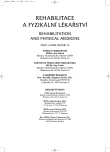Viscoelastic Properties of Fibrous Connective Tissue and Manual Treatment
Authors:
M. Mikova 1,4; A. Krobot 1; M. Janura 2; E. Janurová 3
Authors‘ workplace:
Klinika rehabilitačního a tělovýchovného lékařství LF UP a FN, Olomouc
1; Katedra biomechaniky a technické kybernetiky FTK UP, Olomouc
2; Institut fyziky, Hornicko-geologická fakulta, VŠB – Technická univerzita, Ostrava
3; Rehabilitační oddělení, Nemocnice České Budějovice, a. s.
4
Published in:
Rehabil. fyz. Lék., 15, 2008, No. 1, pp. 3-10.
Category:
Original Papers
Overview
The paper deals with viscoelastic and other physical phenomena, characterizing the properties of connective tissues and applicable in manual treatment of motor disorders. The biological connective tissues are, from physical point of view, non-Newton fluids, viscosity of which depends on momentary changes of shear load. Therefore, in manual treatment there are important strength and velocity parameters of palpation. The authors briefly recapitulate the knowledge of rheology and histology of connective tissues, which commonly characterize thixotropy as an apparent change of connective tissue viscosity. At the same time the authors refer to recent knowledge of contractile elements of perimysium, activity of which commonly form clinical picture of muscular tightness.
Key words:
connective tissue, perimysium, viscoelasticity, thixotropy, myofibroblast, intervention therapy, manual treatment
Sources
1. DESMOULIERE, A. et al.: Tissue repair, contraction, and the myofibroblast. Wound repair regen, 13, 2005, 1, pp. 7-12.
2. GABRHELÍK, T., MAREK, O., KROBOT, A., MÍKOVÁ, M.: Anesteziologické a algeziologické techniky v rámci rehabilitace poruch ramene. Rehabilitace a fyzikální lékařství, 1, 2004, s. 25-32.
3. Mc HUGH, M. P., MAGNUSSON, S. P., GLEIM, G. W., NICHOLAS, J. A.: Viscoelastic stress relaxation in human skeletal muscle. Med Sci Sports Exerc, 24, 1992, 12, pp. 1375-1382.
4. WEIN, O., WICHTERLE, K., MITSCHKA, P.: Inženýrství nenewtonských kapalin I. Chemický průmysl, 21, 1971, 3, s. 121-128.
5. HLAVINKOVÁ, B., MRÁZKOVÁ, M.: Pružnost a pevnost I. [učební texty]. Brno, VUT, 1980.
6. JANURA, M.: Úvod do biomechaniky pohybového systému [učební texty]. Olomouc, Univerzita Palackého, 2003.
7. NORDIN, M., FRANKEL, V. H.: Basic biomechanics of the musculoskeletal system. Baltimore, Lippincott Williams & Wilkins, 1989.
8. BARTOVSKÁ, L., ŠIŠKOVÁ, M.: Co je co v povrchové a koloidní chemii verze 1.0. [elektronické učební texty]. Dostupné na:
<http://vydavatelstvi.vscht.cz/knihy/uid_es-001/hesla/-/tixotropie.html> Praha, VŠCHT, 2005. Citováno dne 5. 10. 2007.
9. AXELSON, H.: Muscle thixotropy: Implications for human motor control. Digital Comprehensive Summaries of Uppsala Dissertations from the Faculty of Medicine 38. Uppsala, 2005. Dostupné na:
http://www.divaportal.org/diva/getDocument?urn_nbn_se-_uu_diva-5791-2__fulltext.pdf. Citováno dne 5. 10. 2007.
10. PROSKE, U., MORGAN, D. L., GREGORY, J. E. Thixotropy in skeletal muscle and in muscle spindles: A review. Prog. Neurobiol, 41, 1993, 6, pp. 705-721.
11. ENOKA, R. M.: Neuromechanical basis of kinesiology (2nd ed.). Champaigne, IL: Human Kinetics, 1995.
12. JANQUEIRA, L. C. et al.: Basic histology. (6th ed.). San Mateo, Appleton and Lange, 1990.
13. JELÍNEK R. et al.: Histologie, embryologie [elektronické učební texty]. Dostupné na: http://www.lf3.cuni.cz/histologie/materialy/doc/sktipta.pdf. Praha, 3. LF UK, 2005. Citováno 10. 10. 2007.
14. GRIMMEL, F.: Fibroblasts, myofibroblasts and wound contraction. J. Cell. Biol., 124, 1994, 4, pp. 401-404.
15. SCHLEIP, R. et al.: Passive muscle stiffness may be influenced by active contractility of intramuscular connective tissue. Medical Hypothesis, 66, 2006, pp. 66-71.
16. SCHLEIP, R. et al.: Active fascicle contractility: Fascia may be able to contract in a smooth muscle-like manner and thereby influence musculosceletal dynamics. Medical Hypothesis, 65, 2005, pp. 273-277.
17. RICE, N. A., LEINWAND, L. A.: Skeletal myosin heavy chain function in cultured lung myofibroblasts. J. Cell. Biol., 163, 2003, 1, pp. 119-129.
18. WILLIAMS, P. E., GOLDSPINK, G.: Connective tissue changes in immobilised muscle. J. Anatomy, 18, 1984, 4, 2, pp. 343-350.
19. KOLEKTIV AUTORŮ: Patobiomechanika a pato-kineziologie - kompendium [elektronické učební texty]. Dostupné na:
http://biomech.ftvs.cuni.cz/pbpk/kompendium/index.php. Citováno dne 10. 5. 2007.
Labels
Physiotherapist, university degree Rehabilitation Sports medicineArticle was published in
Rehabilitation & Physical Medicine

2008 Issue 1
Most read in this issue
- Viscoelastic Properties of Fibrous Connective Tissue and Manual Treatment
- Vibration: Neurophysiological Aspects and Possibilities of Clinical Application
- Active Life Style and its Changes in Patients with Chronic Low-Back Pain
- Recognize of Motor Disorders in First Year Life - Sensitivity and Specificity of Position Reactions
